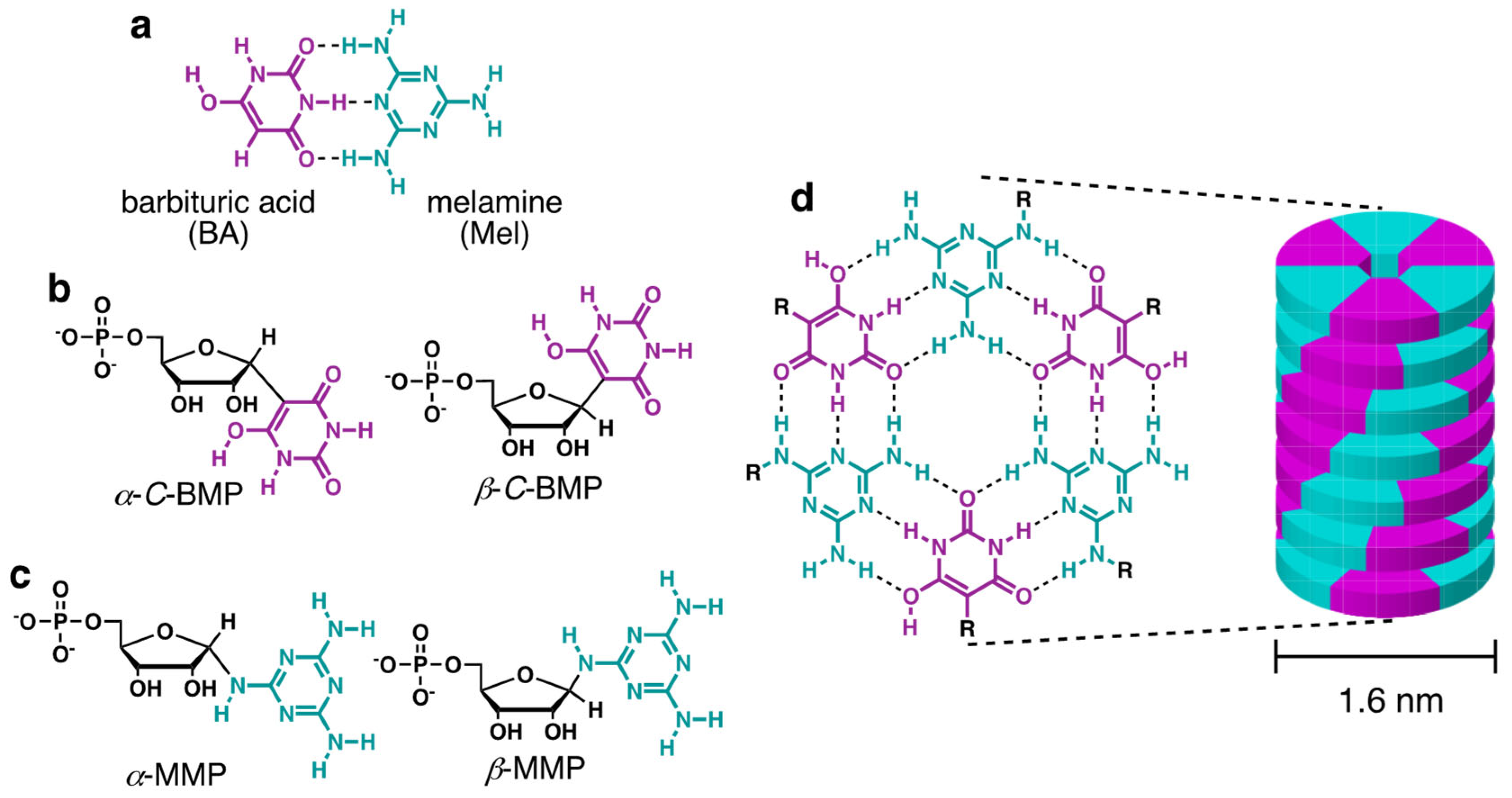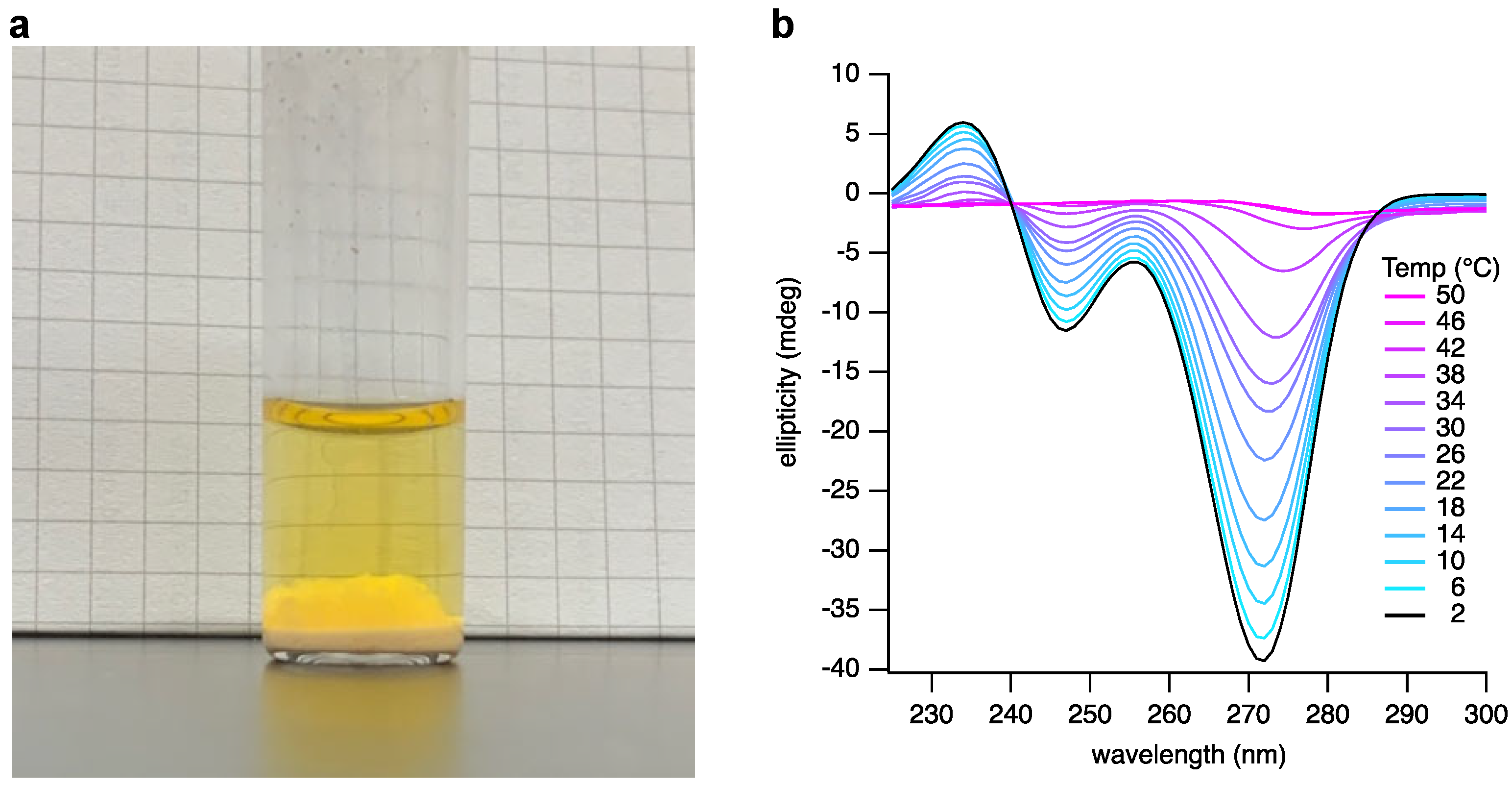One-Pot Formation of Pairing Proto-RNA Nucleotides and Their Supramolecular Assemblies
Abstract
:1. Introduction
2. Materials and Methods
2.1. Chemicals
2.2. Preparation of Experimental Mixtures
2.3. Analysis
3. Results
One-Pot Formation of Nucleotides
4. Discussion
Author Contributions
Funding
Institutional Review Board Statement
Informed Consent Statement
Data Availability Statement
Acknowledgments
Conflicts of Interest
References
- Gesteland, R.F.; Cech, T.R.; Atkins, J.F. The RNA World, 3rd ed.; Cold Spring Harbor Laboratory Press: Long Island, NY, USA, 2006; p. 768. [Google Scholar]
- Walter, G. The RNA World. Nature 1986, 319, 618. [Google Scholar]
- Neveu, M.; Kim, H.J.; Benner, S.A.; Farfán-García, E.; Castillo-Mendieta, N.; Ciprés-Flores, F.; Padilla-Martínez, I.; Trujillo-Ferrara, J.; Soriano-Ursúa, M.; de Farias, S.; et al. The “strong” RNA world hypothesis: Fifty years old. Astrobiology 2013, 13, 391–403. [Google Scholar] [CrossRef] [PubMed]
- Yadav, M.; Kumar, R.; Krishnamurthy, R. The chemistry of abiotic nucleotide synthesis. Chem. Rev. 2020, 120, 4766–4805. [Google Scholar] [CrossRef] [PubMed]
- Becker, S.; Feldmann, J.; Wiedemann, S.; Okamura, H.; Schneider, C.; Iwan, K.; Crisp, A.; Rossa, M.; Amatov, T.; Carell, T. Unified prebiotically plausible synthesis of pyrimidine and purine RNA ribonucleotides. Science 2019, 366, 76–82. [Google Scholar] [CrossRef] [PubMed]
- Engelhart, A.E.; Hud, N.V. Primitive genetic polymers. Cold Spring Harb. Perspect. Biol. 2010, 2, a002196. [Google Scholar] [CrossRef] [PubMed]
- Hud, N.V.; Cafferty, B.J.; Krishnamurthy, R.; Williams, L.D. The origin of RNA and ‘My Grandfather’s Axe’. Chem. Biol. 2013, 20, 466–474. [Google Scholar] [CrossRef] [PubMed]
- Fialho, D.M.; Roche, T.P.; Hud, N.V. Prebiotic syntheses of noncanonical nucleosides and nucleotides. Chem. Rev. 2020, 120, 4806–4830. [Google Scholar] [CrossRef] [PubMed]
- Eschenmoser, A. Etiology of potentially primordial biomolecular structures: From vitamin B12 to the nucleic acids and an inquiry into the chemistry of life’s origin: A retrospective. Angew. Chem. Int. Ed. 2011, 50, 12412–12472. [Google Scholar] [CrossRef] [PubMed]
- Hoshika, S.; Leal, N.A.; Kim, M.-J.; Kim, M.-S.; Karalkar, N.B.; Kim, H.-J.; Bates, A.M.; Watkins, N.E.; SantaLucia, H.A.; Meyer, A.J.; et al. Hachimoji DNA and RNA: A genetic system with eight building blocks. Science 2019, 363, 884–887. [Google Scholar] [CrossRef] [PubMed]
- Schuster, G.B.; Cafferty, B.J.; Karunakaran, S.C.; Hud, N.V. Water-soluble supramolecular polymers of paired and stacked heterocycles: Assembly, structure, properties, and a possible path to pre-RNA. J. Am. Chem. Soc. 2021, 143, 9279–9296. [Google Scholar] [CrossRef] [PubMed]
- Chen, M.C.; Cafferty, B.J.; Mamajanov, I.; Gállego, I.; Khanam, J.; Krishnamurthy, R.; Hud, N.V. Spontaneous prebiotic formation of a β-ribofuranoside that self-assembles with a complementary heterocycle. J. Am. Chem. Soc. 2014, 136, 5640–5646. [Google Scholar] [CrossRef] [PubMed]
- Cafferty, B.J.; Fialho, D.M.; Khanam, J.; Krishnamurthy, R.; Hud, N.V. Spontaneous formation and base pairing of plausible prebiotic nucleotides in water. Nat. Commun. 2016, 7, 11328. [Google Scholar] [CrossRef] [PubMed]
- Fialho, D.M.; Clarke, K.C.; Moore, M.K.; Schuster, G.B.; Krishnamurthy, R.; Hud, N.V. Glycosylation of a model proto-RNA nucleobase with non-ribose sugars: Implications for the prebiotic synthesis of nucleosides. Org. Biomol. Chem. 2018, 16, 1263–1271. [Google Scholar] [CrossRef] [PubMed]
- Roche, T.P.; Fialho, D.M.; Menor-Salván, C.; Krishnamurthy, R.; Schuster, G.B.; Hud, N.V. A Plausible Prebiotic Path to Nucleosides: Ribosides and Related Aldosides Generated from Ribulose, Fructose, and Similar Abiotic Precursors. Chem. Eur. J. 2022, 29, e202203036. [Google Scholar] [CrossRef] [PubMed]
- Menor-Salvan, C.; Ruiz-Bermejo, D.M.; Guzman, M.I.; Osuna-Esteban, S.; Veintemillas-Verdaguer, S. Synthesis of pyrimidines and triazines in ice: Implications for the prebiotic chemistry of nucleobases. Chem. Eur. J. 2009, 15, 4411–4418. [Google Scholar] [CrossRef] [PubMed]
- Sancier, K.M.; Brady, A.P.; Lee, W.W. Absorption spectra of solutions of cyanuric acid and its chlorinated derivatives. Spectrochim. Acta 1964, 20, 397–403. [Google Scholar] [CrossRef]
- Ortiz-Rodríguez, L.A.; Hoehn, S.J.; Crespo-Hernández, C.E. On the Photostability of Cyanuric Acid and Its Candidature as a Prebiotic Nucleobase. Molecules 2022, 27, 1184. [Google Scholar] [CrossRef] [PubMed]
- Whitesides, G.M.; Simanek, E.E.; Mathias, J.P.; Seto, C.T.; Chin, D.N.; Mammen, M.; Gordon, D.M. Noncovalent synthesis: Using physical-organic chemistry to make aggregates. Acc. Chem. Res. 1995, 28, 37–44. [Google Scholar] [CrossRef]
- Fox, J.J.; Shugar, D. Absorption Spectra and Structure of Barbituric Acid Derivatives as a Function of pH. Bull. Soc. Chim. Belg. 1952, 61, 44–63. [Google Scholar] [CrossRef]
- Alenaizan, A.; Borca, C.H.; Karunakaran, S.C.; Kendall, A.K.; Stubbs, G.; Schuster, G.B.; Sherrill, C.D.; Hud, N.V. X-ray Fiber Diffraction and Computational Analyses of Stacked Hexads in Supramolecular Polymers: Insight into Self-Assembly in Water by Prospective Prebiotic Nucleobases. J. Am. Chem. Soc. 2021, 143, 6079–6094. [Google Scholar] [CrossRef] [PubMed]




Disclaimer/Publisher’s Note: The statements, opinions and data contained in all publications are solely those of the individual author(s) and contributor(s) and not of MDPI and/or the editor(s). MDPI and/or the editor(s) disclaim responsibility for any injury to people or property resulting from any ideas, methods, instructions or products referred to in the content. |
© 2023 by the authors. Licensee MDPI, Basel, Switzerland. This article is an open access article distributed under the terms and conditions of the Creative Commons Attribution (CC BY) license (https://creativecommons.org/licenses/by/4.0/).
Share and Cite
Roche, T.P.; Nedumpurath, P.J.; Karunakaran, S.C.; Schuster, G.B.; Hud, N.V. One-Pot Formation of Pairing Proto-RNA Nucleotides and Their Supramolecular Assemblies. Life 2023, 13, 2200. https://doi.org/10.3390/life13112200
Roche TP, Nedumpurath PJ, Karunakaran SC, Schuster GB, Hud NV. One-Pot Formation of Pairing Proto-RNA Nucleotides and Their Supramolecular Assemblies. Life. 2023; 13(11):2200. https://doi.org/10.3390/life13112200
Chicago/Turabian StyleRoche, Tyler P., Pranav J. Nedumpurath, Suneesh C. Karunakaran, Gary B. Schuster, and Nicholas V. Hud. 2023. "One-Pot Formation of Pairing Proto-RNA Nucleotides and Their Supramolecular Assemblies" Life 13, no. 11: 2200. https://doi.org/10.3390/life13112200
APA StyleRoche, T. P., Nedumpurath, P. J., Karunakaran, S. C., Schuster, G. B., & Hud, N. V. (2023). One-Pot Formation of Pairing Proto-RNA Nucleotides and Their Supramolecular Assemblies. Life, 13(11), 2200. https://doi.org/10.3390/life13112200








